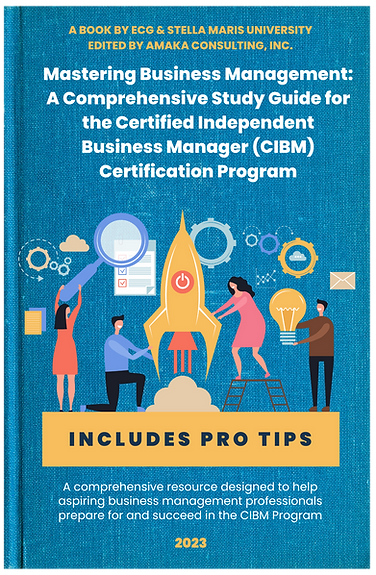
Certified Independent Business Manager - II (CIBM-II)
This certification focuses on enhancing individuals' knowledge and skills related to planning, organizing, and managing resources and teams within an organization. It emphasizes the importance of strategic planning, value-chain management, organizational structure, and human resource management.
CIBM-II Certifications
EXAM CONTENT
Planning and Strategy
Value-Chain Management
Organizational Structure and Culture
Managing a Diverse Workforce
Building High-Performance Teams
Human Resource Management
Coaching and Performance Feedback
Networking and Mentoring
Project Management
Running Effective Meetings


EXAM SPECIFICATION
Domain 1: Planning (29%)
Domain 2: Organizing (25%)
Domain 3: Talent/Human Resource Management (46%)
The exam consists of 100 multiple-choice questions and is time-limited to a maximum of 120 minutes. It is administered through ECG's e-Learning Center and can be taken electronically or manually. Test takers receive immediate pass or fail results on-screen for electronically taken exams, and detailed feedback is sent by email after grading.
Weighted Percentage
A possible weighted point or percentage assignment for CIBM™ Certification:
Competencies Area: 65%
General Business Knowledge Area: 35%
This allocation would assign 100% of the total points or percentage to the competencies and AEM categories covered in the certification program. The specific weights could be adjusted based on the importance of each competency and AEM category to the overall program goals and objectives.

Proficiency and Measurement Criteria for the Competencies in BEX® Certification
Distinguished:
Demonstrates mastery of the published competencies at a level exceeding certification level expectations as defined in the BEX General Competency Guide; and its application in real business situations.
Proficient:
Demonstrates mastery of the published competencies at a level meeting certification expectations as defined in the BEX General Competency Guide; and shows an ability to analyze problems related to the competency and develop effective solutions.
Basic:
Demonstrates published competencies at a level of performance minimally meeting certification expectations as defined in the BEX General Competency Guide; and displays effective communication and collaboration skills related to the competency, including the ability to work with stakeholders and manage relationships effectively.
Non-performance:
Demonstrates published competencies at a level which does not meet certification expectations as described in the BEX General Competency Guide.
The "Mastering Business Management" study guide is a comprehensive resource designed to help aspiring business management professionals prepare for and succeed in the Certified Independent Business Manager (CIBM) certification program. With a focus on key principles and practical skills, this guide covers all three levels of the CIBM program, including Management Essentials, Planning and Organizing, and Leading and Controlling.
Throughout the guide, readers will benefit from practical examples, real-world case studies, and self-assessment questions that reinforce learning and promote critical thinking. The "Mastering Business Management" study guide is an invaluable tool for individuals seeking to elevate their careers in business management and attain the prestigious CIBM certification. Whether you are new to the field or an experienced professional looking to enhance your skills, this guide will provide the knowledge and expertise needed to excel in today's dynamic business environment.

Five (5) Sample CIBM-II Certification Exam Questions
The exam consists of 100 multiple-choice questions and is time-limited to a maximum of 120 minutes.
Question 1:
Value-chain management is an important aspect of strategic planning. Which of the following best describes the primary goal of value-chain management?
A. To maximize profits by increasing prices
B. To create and deliver value at each stage of the production process
C. To minimize employee involvement in decision-making
D. To centralize all business operations in one location
Correct Answer: B. To create and deliver value at each stage of the production process
Value-chain management involves optimizing each stage of the production process to create and deliver maximum value to customers while minimizing costs.
Question 2:
Which of the following organizational structures is characterized by clear lines of authority, a hierarchical structure, and well-defined roles and responsibilities?
A. Flat structure
B. Matrix structure
C. Functional structure
D. Network structure
Correct Answer: C. Functional structure
A functional organizational structure is characterized by a hierarchical arrangement of employees based on their functional areas of expertise, with clear lines of authority and well-defined roles.
Question 3:
When managing a diverse workforce, what is a key consideration for promoting inclusivity and effective collaboration?
A. Encouraging competition between employees
B. Emphasizing cultural differences between team members
C. Fostering an inclusive environment that respects and values diversity
D. Implementing a one-size-fits-all approach to team management
Correct Answer: C. Fostering an inclusive environment that respects and values diversity
An inclusive environment that respects and values diversity encourages collaboration, creativity, and engagement among team members with diverse backgrounds and perspectives.
Question 4:
What is the primary goal of performance feedback in the context of human resource management?
A. To document employee misconduct
B. To provide constructive feedback and support employee development
C. To compare employees and create a competitive environment
D. To identify employees who should be terminated
Correct Answer: B. To provide constructive feedback and support employee development
Performance feedback aims to provide constructive feedback to employees, identify areas of improvement, and support their growth and development.
Question 5:
Which of the following is an essential component of effective project management?
A. Avoiding communication with stakeholders
B. Ignoring project timelines and deadlines
C. Clearly defining project goals, objectives, and deliverables
D. Excluding team members from the decision-making process
Correct Answer: C. Clearly defining project goals, objectives, and deliverables
Clearly defining project goals, objectives, and deliverables is essential for effective project management, as it provides a roadmap for successful project execution and ensures alignment among team members and stakeholders.
Please note that these questions are sample questions intended for study and exam preparation purposes. The actual certification exam may contain questions that are structured differently or that cover additional topics.

